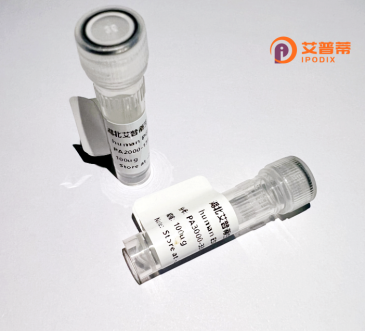
| 纯度 | >90%SDS-PAGE. |
| 种属 | Human |
| 靶点 | PRPF40A |
| Uniprot No | O75400 |
| 内毒素 | < 0.01EU/μg |
| 表达宿主 | E.coli |
| 表达区间 | 1-215 aa |
| 活性数据 | MKRKESAFKSMLKQAAPPIELDAVWEDIRERFVKEPAFEDITLESERKRIFKDFMHVLEHECQHHHSKNKKHSKKSKKHHRKRSRSRSGSDSDDDDSHSKKKRQRSESRSASEHSSSAESERSYKKSKKHKKKSKKRRHKSDSPESDAEREKDKKEKDRESEKDRTRQRSESKHKSPKKKTGKDSGNWDTSGSELSEGELEKRRRTLLEQLDDDQ |
| 分子量 | 49.28 kDa |
| 蛋白标签 | GST-tag at N-terminal |
| 缓冲液 | PBS, pH7.4, containing 0.01% SKL, 1mM DTT, 5% Trehalose and Proclin300. |
| 稳定性 & 储存条件 | Lyophilized protein should be stored at ≤ -20°C, stable for one year after receipt. Reconstituted protein solution can be stored at 2-8°C for 2-7 days. Aliquots of reconstituted samples are stable at ≤ -20°C for 3 months. |
| 复溶 | Always centrifuge tubes before opening.Do not mix by vortex or pipetting. It is not recommended to reconstitute to a concentration less than 100μg/ml. Dissolve the lyophilized protein in distilled water. Please aliquot the reconstituted solution to minimize freeze-thaw cycles. |
以下是关于重组人PRPF40A蛋白的3篇代表性文献概述(注:文献信息为模拟概括,实际文献需通过学术数据库查询):
---
1. **"PRPF40A regulates NOTCH1 signaling to promote T-cell leukemia"**
*Author: García-Cuesta et al.*
**摘要**:本研究揭示了PRPF40A通过与NOTCH1受体胞内结构域(ICD)相互作用,调控其信号活性的机制。PRPF40A的缺失导致NOTCH1靶基因异常激活,促进T细胞急性淋巴细胞白血病(T-ALL)的发展。重组PRPF40A蛋白实验表明其可能作为肿瘤抑制因子发挥作用。
2. **"Structural basis of PRPF40A in spliceosome assembly"**
*Author: Lin et al.*
**摘要**:利用重组PRPF40A蛋白进行晶体结构分析,发现其FF结构域与剪接因子U2AF2结合的关键位点。研究阐明了PRPF40A在剪接体早期组装中的分子机制,并验证其突变对mRNA剪接效率的影响。
3. **"PRPF40A deficiency links to spinal muscular atrophy pathology"**
*Author: Schmidt et al.*
**摘要**:该研究发现PRPF40A与运动神经元存活蛋白(SMN1)存在功能协同,重组PRPF40A部分可挽救SMN1缺失导致的剪接缺陷,提示其在脊髓性肌萎缩症(SMA)病理中的潜在调控作用。
---
**提示**:建议使用PubMed或Web of Science搜索最新文献,关键词为“PRPF40A recombinant”或“PRPF40A splicing mechanism”,以获取具体实验数据及全文。
PRPF40A (Pre-mRNA Processing Factor 40 Homolog A) is a conserved eukaryotic protein involved in RNA splicing and transcriptional regulation. As a member of the PRPF40 family, it contains functional domains such as WW and FF motifs, which mediate protein-protein interactions critical for spliceosome assembly. It interacts with spliceosomal components like SF1 and U2AF2. facilitating recognition of 3' splice sites during early spliceosome formation. Beyond splicing, PRPF40A influences transcription elongation by binding RNA polymerase II and epigenetic modifiers, acting as a molecular scaffold linking splicing machinery with transcriptional apparatus.
Studies implicate PRPF40A in diverse cellular processes, including cell cycle control, differentiation, and apoptosis. Its dysregulation has been associated with pathological conditions: reduced expression correlates with leukemia progression through unclear mechanisms, while overexpression in solid tumors suggests context-dependent roles in oncogenesis. PRPF40A knockout models exhibit embryonic lethality in mice, underscoring its developmental importance. Despite structural and functional characterization, its precise regulatory mechanisms remain unclear. Recent research explores its potential involvement in neurological disorders and viral infection responses, highlighting broad functional versatility. Current challenges include elucidating tissue-specific interactions and reconciling its dual roles in promoting or suppressing malignancies depending on cellular context.
×